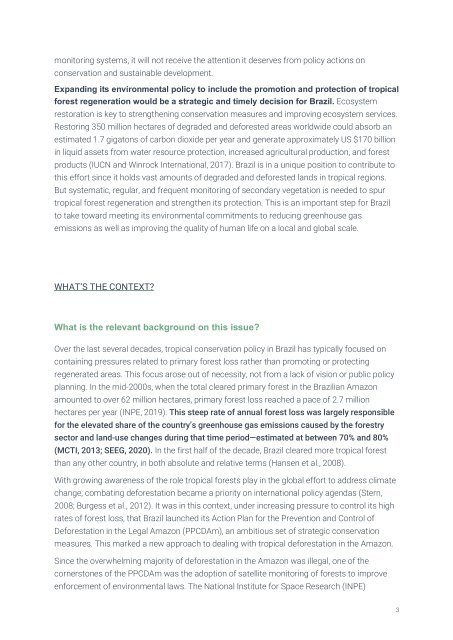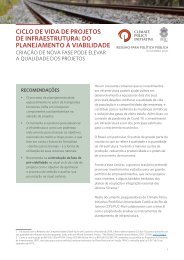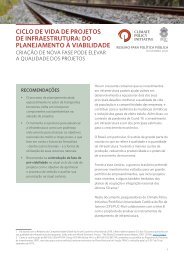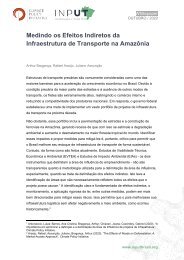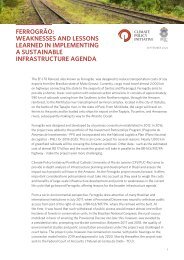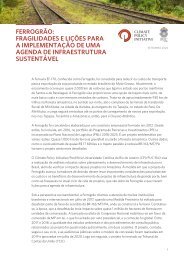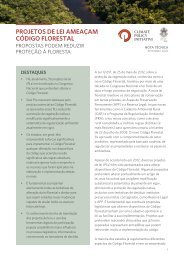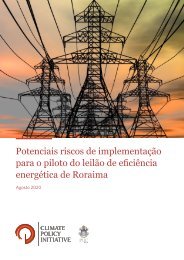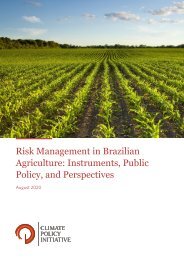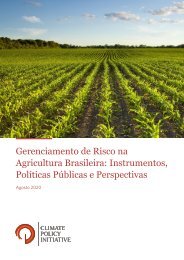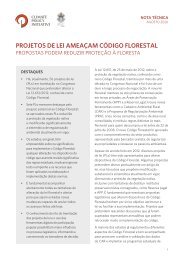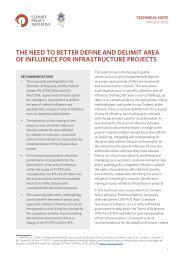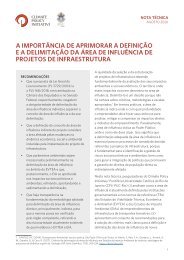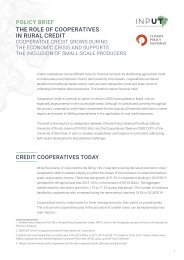Brazil Needs to Monitor its Tropical Regeneration
You also want an ePaper? Increase the reach of your titles
YUMPU automatically turns print PDFs into web optimized ePapers that Google loves.
moni<strong>to</strong>ring systems, it will not receive the attention it deserves from policy actions on<br />
conservation and sustainable development.<br />
Expanding <strong>its</strong> environmental policy <strong>to</strong> include the promotion and protection of tropical<br />
forest regeneration would be a strategic and timely decision for <strong>Brazil</strong>. Ecosystem<br />
res<strong>to</strong>ration is key <strong>to</strong> strengthening conservation measures and improving ecosystem services.<br />
Res<strong>to</strong>ring 350 million hectares of degraded and deforested areas worldwide could absorb an<br />
estimated 1.7 giga<strong>to</strong>ns of carbon dioxide per year and generate approximately US $170 billion<br />
in liquid assets from water resource protection, increased agricultural production, and forest<br />
products (IUCN and Winrock International, 2017). <strong>Brazil</strong> is in a unique position <strong>to</strong> contribute <strong>to</strong><br />
this effort since it holds vast amounts of degraded and deforested lands in tropical regions.<br />
But systematic, regular, and frequent moni<strong>to</strong>ring of secondary vegetation is needed <strong>to</strong> spur<br />
tropical forest regeneration and strengthen <strong>its</strong> protection. This is an important step for <strong>Brazil</strong><br />
<strong>to</strong> take <strong>to</strong>ward meeting <strong>its</strong> environmental commitments <strong>to</strong> reducing greenhouse gas<br />
emissions as well as improving the quality of human life on a local and global scale.<br />
WHAT’S THE CONTEXT?<br />
What is the relevant background on this issue?<br />
Over the last several decades, tropical conservation policy in <strong>Brazil</strong> has typically focused on<br />
containing pressures related <strong>to</strong> primary forest loss rather than promoting or protecting<br />
regenerated areas. This focus arose out of necessity, not from a lack of vision or public policy<br />
planning. In the mid-2000s, when the <strong>to</strong>tal cleared primary forest in the <strong>Brazil</strong>ian Amazon<br />
amounted <strong>to</strong> over 62 million hectares, primary forest loss reached a pace of 2.7 million<br />
hectares per year (INPE, 2019). This steep rate of annual forest loss was largely responsible<br />
for the elevated share of the country’s greenhouse gas emissions caused by the forestry<br />
sec<strong>to</strong>r and land-use changes during that time period—estimated at between 70% and 80%<br />
(MCTI, 2013; SEEG, 2020). In the first half of the decade, <strong>Brazil</strong> cleared more tropical forest<br />
than any other country, in both absolute and relative terms (Hansen et al., 2008).<br />
With growing awareness of the role tropical forests play in the global effort <strong>to</strong> address climate<br />
change, combating deforestation became a priority on international policy agendas (Stern,<br />
2008; Burgess et al., 2012). It was in this context, under increasing pressure <strong>to</strong> control <strong>its</strong> high<br />
rates of forest loss, that <strong>Brazil</strong> launched <strong>its</strong> Action Plan for the Prevention and Control of<br />
Deforestation in the Legal Amazon (PPCDAm), an ambitious set of strategic conservation<br />
measures. This marked a new approach <strong>to</strong> dealing with tropical deforestation in the Amazon.<br />
Since the overwhelming majority of deforestation in the Amazon was illegal, one of the<br />
corners<strong>to</strong>nes of the PPCDAm was the adoption of satellite moni<strong>to</strong>ring of forests <strong>to</strong> improve<br />
enforcement of environmental laws. The National Institute for Space Research (INPE)<br />
3


